Timeline of the 1974 Atlantic hurricane season
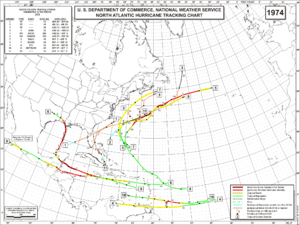
The 1974 Atlantic hurricane season is one of the deadliest Atlantic hurricane seasons with more than 6,000 dead.[1] During the season, twenty tropical or subtropical depressions formed, of which eleven reached tropical storm intensity.[2][3] Four of those tropical storms became hurricanes and two of those became major hurricanes.[2] The season officially began on June 1, 1974, and ended on November 30. These dates typically limit the period of each year when most tropical cyclones form in the eastern North Atlantic hurricane basin. This timeline documents all the storm formations, strengthening, weakening, landfalls, extratropical transitions, as well as dissipation. The timeline also includes information which was not operationally released, meaning that information from post-storm reviews by the National Hurricane Center, such as information on a storm that was not operationally warned on, has been included.
The first storm of the season, Tropical Depression One, formed on June 22. The final storm of the season, Tropical Depression Seventeen, dissipated on November 11. There were twenty tropical cyclones during the season. Of these, four were subtropical storms, and sixteen were tropical. Of these tropical systems, four became hurricanes; two of those reached Category 3 intensity or higher on the Saffir-Simpson hurricane scale. Hurricane Carmen threatened two major cities during its duration, Belize City, Belize and New Orleans, Louisiana, but veered away at the last moment.[4] Hurricane Fifi is among the deadliest storms in the Atlantic Basin with fatality estimates ranging from 6,000 to 8,000.[1]
Timeline of Recent Events

June
- June 1
- The 1974 Atlantic hurricane season officially begins.[5]
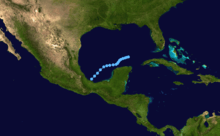
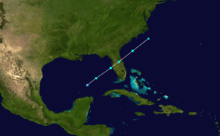
- June 24
- 1800 UTC (1 p.m. CDT) - Subtropical Depression One forms in the Gulf of Mexico.[6]
- June 25
- 0000 UTC (7 p.m. CDT June 24) - Subtropical Depression One strengthens into a subtropical storm.[6]
- 1200 UTC (7 a.m. CDT) - Subtropical Storm One reaches its peak intensity and makes landfall just north of Tampa, Florida, with winds of 65 mph (100 km/h).[6]
- June 26
July

- July 13
- 1800 UTC (1 p.m. CDT) - Tropical Depression Two forms in the northern Gulf of Mexico just south of the Florida Panhandle.[3]
- July 16
- 0000 UTC (8 p.m. EDT July 15) - Subtropical Depression Two forms off the Eastern coast of the United States.[7]
- July 17
- 1200 UTC (8 a.m. EDT) - Subtropical Depression Two strengthens into a subtropical storm.[7]
- 1800 UTC (1 p.m. CDT) - Tropical Depression Two makes landfall near Galveston, Texas, and dissipates.[3]
- July 18
- 1200 UTC (8 a.m. EDT) - Subtropical Storm Two reaches its peak intensity of 50 mph (85 km/h).[7]
- July 20
- 0000 UTC (8 p.m. EDT July 19) - Subtropical Storm Two becomes extratropical east of Newfoundland, Canada.[7]
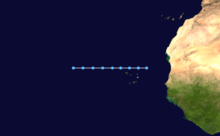
- July 31
- 1200 UTC (10 a.m. AST) - Tropical Depression Three forms just northwest of the Cape Verde Islands off the coast of Africa.[3]
August
- August 2
- 1200 UTC (10 a.m. AST) - Tropical Depression Three dissipates in the central Atlantic Ocean.[3]
- August 10
- 1200 UTC (8 a.m. EDT) - Subtropical Storm Three forms south of Cape Cod, Massachusetts.[8]
- August 12
- 1200 UTC (8 a.m. EDT) - Tropical Depression Four forms in the southern tropical Atlantic Ocean.[9]
- August 13
- August 14
- 1200 UTC (8 a.m. EDT) - Tropical Storm Alma makes landfall on Trinidad and Tobago with winds of 40 mph (65 km/h).[9]
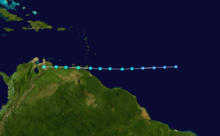
- August 15
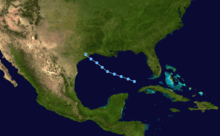
- August 24
- 1200 UTC (7 a.m. CDT) - Tropical Depression Five forms north of Cuba in the Gulf of Mexico.[3]
- August 26
- 1200 UTC (8 a.m. EDT) - Tropical Depression Six forms in the central Atlantic far from land.[10]
- 1200 UTC (7 a.m. CDT) - Tropical Depression Five makes landfall near Galveston, Texas, and dissipates.[3]
- August 28
- August 29
- 0600 UTC (2 a.m. EDT) - Tropical Depression Seven forms off the Greater Antilles.[11]
- 1200 UTC (8 a.m. EDT) - Hurricane Becky reaches category 2 hurricane strength.[10]
- August 30
- 0600 UTC (2 a.m. EDT) - Hurricane Becky reaches major hurricane strength and a peak intensity of 115 mph (185 km/h).[10]
- 1200 UTC (8 a.m. EDT) - Tropical Depression Seven strengthens into a tropical storm and is named Carmen.[11]
- August 31
September
- September 1
- 0600 UTC (2 a.m. EDT) - Hurricane Carmen becomes a category 2 hurricane.[11]
- 1200 UTC (8 a.m. EDT) - Hurricane Carmen becomes a major hurricane.[11]
- 1200 UTC (8 a.m. EDT) - Hurricane Becky weakens into a category 1 hurricane.[10]
- 1800 UTC (2 p.m. EDT) - Hurricane Carmen becomes a category 4 hurricane.[11]
- September 2
- 0000 UTC (9 pm. AST September 1) - Hurricane Becky weakens into a tropical storm.[10]
- 0600 UTC (1 a.m. CDT) - Hurricane Carmen reaches its peak intensity of 150 mph (240 km/h).[11]
- 1200 UTC (7 a.m. CDT) - Hurricane Carmen makes landfall on the Yucatan Peninsula with winds of 140 mph (220 km/h).[11]
- 1200 UTC (8 a.m. EDT) - Tropical Storm Becky becomes extratropical in the frigid waters of the North Atlantic Ocean.[10]
- 1800 UTC (2 p.m. EDT) - Tropical Depression Nine forms in the central Atlantic ocean.[12]
- 1200 UTC (3 p.m. AST) - Tropical Depression Eight forms off the coast of Africa.[3]
- 1800 UTC (1 p.m. CDT) - Hurricane Carmen weakens into a category 2 hurricane.[11]
- September 3
- September 4
- 1800 UTC (2 p.m. EDT) - Tropical Depression Ten forms in the central Atlantic Ocean.[13]
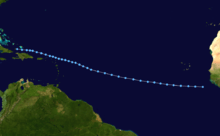
- September 5
- September 6
- 1800 UTC (1 p.m. CDT) - Hurricane Carmen restrengthens into a category 2 hurricane.[11]
- September 7
- September 8
- 0000 UTC (7 p.m. CDT September 7) - Hurricane Carmen regains its peak intensity of 150 mph (240 km/h).[11]
- 0600 UTC (1 a.m. CDT) - Hurricane Carmen weakens into a category 3 hurricane as it makes landfall south of Morgan City, Louisiana, with winds of 120 mph (195 km/h).[11]
- 1200 UTC (7 a.m. CDT) - Hurricane Carmen weakens into a category 1 hurricane.[11]
- 1800 UTC (1 p.m. CDT) - Hurricane Carmen weakens into a tropical storm.[11]
- September 9
- September 10
- 0600 UTC (1 a.m. CDT) - Tropical Depression Carmen dissipates just southeast of Waco, Texas.[11]
- 1200 UTC (8 a.m. EDT) - Tropical Storm Elaine reaches its peak intensity of 70 mph (110 km/h).[13]
- September 11
- 1200 UTC (8 a.m. EDT) - Tropical Depression Eight makes landfall of Great Inagua Island in the Bahamas and dissipates.[3]
- September 14
- 0000 UTC (8 p.m. EDT September 13) - Tropical Storm Elaine becomes extratropical in the cold waters of the North Atlantic Ocean.[13]
- 1200 UTC (8 a.m. EDT) - Tropical Depression Eleven forms in the Caribbean Sea just south of Puerto Rico.[14]
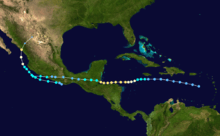
- September 16
- 1800 UTC (2 p.m. EDT) - Tropical Depression Eleven strengthens into a tropical storm and is named Fifi.[14]
- September 17
- 0600 UTC (2 a.m. EDT) - Tropical Storm Fifi becomes a hurricane.[14]
- September 18
- 0600 UTC (2 a.m. EDT) - Hurricane Fifi strengthens into a category 2 hurricane.[14]
- 1200 UTC (8 a.m. EDT) - Tropical Depression Twelve forms in the central Atlantic Ocean.[3]
- 1800 UTC (1 p.m. CDT) - Hurricane Fifi reaches its peak intensity of 110 mph (180 km/h) while paralleling the Honduran coastline.[14]
- September 20
- 0000 UTC (7 p.m. CDT September 19) - Hurricane Fifi makes landfall at the base of the Yucatan Peninsula in Guatemala with winds of 105 mph (170 km/h) and weakens into a tropical storm.[14]
- 1800 UTC (1 p.m. CDT) - Tropical Storm Fifi weakens into a tropical depression.[14]
- 1800 UTC (2 p.m. EDT) - Tropical Depression Twelve dissipates northwest of Bermuda.[3]
- September 22
- 1200 UTC (4 a.m. PDT) - Tropical Depression Fifi restrengthens into a tropical storm in the Pacific Ocean. Following policy at the time, it is renamed Orlene.[14]
- September 23
- 1200 UTC (8 a.m. EDT) - Tropical Depression Thirteen forms in the western Caribbean Sea.[3]
- September 27
- 1200 UTC (8 a.m. EDT) - Tropical Depression Fourteen forms east of the Lesser Antilles.[15]
- 1200 UTC (8 a.m. EDT) - Tropical Depression Thirteen dissipates just south of Cedar Key, Florida.[3]
- September 28
- 1800 UTC (2 p.m. EDT) - Tropical Depression Fourteen strengthens into a tropical storm and is named Gertrude.[15]
- September 29
- 0000 UTC (8 p.m. EDT September 28) - Tropical Storm Gertrude rapidly strengthens into a hurricane and reaches its peak intensity of 75 mph (120 km/h).[15]
- September 30
- 1800 UTC (2 p.m. EDT) - Hurricane Gertrude weakens into a tropical storm.[15]
October
- October 2
- 1200 UTC (8 a.m. EDT) - Tropical Storm Gertrude weakens into a tropical depression.[15]
- 1800 UTC (2 p.m. EDT) - Tropical Depression Gertrude makes landfall on Carriacou Island in the Grenadines with winds of 35 mph (55 km/h).[15]
- October 4
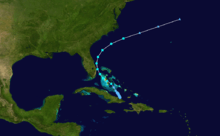
- October 5
- 1200 UTC (8 a.m. EDT) - Tropical Depression Fifteen becomes subtropical.[16]
- October 6
- 0000 UTC (8 p.m. EDT October 5) - The subtropical depression that used to be Tropical Depression Fifteen strengthens into a subtropical storm and is numbered Four.[16]
- 0600 UTC (2 a.m. EDT) - Subtropical Storm Four makes landfall on Grand Bahama Island with winds of 45 mph (70 km/h).[16]
- October 7
- 0000 UTC (8 p.m. EDT October 6) - Subtropical Storm Four reaches its peak intensity of 50 mph (80 km/h).[16]
- October 8
- 1200 UTC (8 a.m. EDT) - Subtropical Storm Four weakens into a subtropical depression and becomes extratropical.[16]
- October 30
- 1200 UTC (8 a.m. EDT) - Tropical Depression Sixteen forms in the central Atlantic Ocean.[3]
November
- November 2
- 1200 UTC (8 a.m. EDT) - Tropical Depression Sixteen dissipates.[3]
- November 10
- 1200 UTC (8 a.m. EDT) - Tropical Depression Seventeen forms north of the Dominican Republic.[3]
- November 12
- 1200 UTC (8 a.m. EDT) - Tropical Depression Seventeen dissipates.[3]
- November 30
- The 1974 Atlantic hurricane season officially ends.[5]
See also
References
- 1 2 Rappaport, Edward N.; Fernandez-Partagas, Jose (May 28, 1995 (updated April 22, 1997)). "Deadliest Atlantic Tropical Cyclones 1492–1996". National Oceanic Atmospheric Administration. Retrieved 2009-06-17. Check date values in:
|date=(help) - 1 2 3 "Atlantic Tropical Cyclones 1851–2008". Atlantic Basin Hurricane Database. Retrieved 2009-06-17.
- 1 2 3 4 5 6 7 8 9 10 11 12 13 14 15 16 17 18 19 "Non Developing Tropical Depressions 1967–87". National Oceanic Atmospheric Administration. Retrieved 2009-06-16.
- ↑ "Season Summary for 1974" (PDF). US Weather Service. Retrieved 2009-06-17.
- 1 2 Atlantic Oceanographic and Meteorological Laboratory, Hurricane Research Division. "Frequently Asked Questions: When is hurricane season?". NOAA. Retrieved 2008-08-21.
- 1 2 3 4 "HURDAT Best Track for Subtropical Storm One". Atlantic Basin Hurricane Database. Retrieved 2009-05-22.
- 1 2 3 4 "HURDAT Best Track for Subtropical Storm Two". Atlantic Basin Hurricane Database. Retrieved 2009-05-22.
- 1 2 3 "HURDAT Best Track for Subtropical Storm Three". Atlantic Basin Hurricane Database. Retrieved 2009-05-22.
- 1 2 3 4 5 6 "HURDAT Best Track for Tropical Storm Alma". Atlantic Basin Hurricane Database. Retrieved 2009-05-22.
- 1 2 3 4 5 6 7 8 9 "HURDAT Best Track for Hurricane Becky". Atlantic Basin Hurricane Database. Retrieved 2009-05-22.
- 1 2 3 4 5 6 7 8 9 10 11 12 13 14 15 16 17 18 19 20 "HURDAT Best Track for Hurricane Carmen". Atlantic Basin Hurricane Database. Retrieved 2009-05-22.
- 1 2 3 "HURDAT Best Track for Tropical Storm Dolly". Atlantic Basin Hurricane Database. Retrieved 2009-06-05.
- 1 2 3 4 "HURDAT Best Track for Tropical Storm Elaine". Atlantic Basin Hurricane Database. Retrieved 2009-06-17.
- 1 2 3 4 5 6 7 8 "HURDAT Best Track Data for Hurricane Fifi". Atlantic Basin Hurricane Database. Retrieved 2009-06-17.
- 1 2 3 4 5 6 7 "HURDAT Best Track for Hurricane Gertrude". Atlantic Basin Hurricane Database. Retrieved 2009-06-17.
- 1 2 3 4 5 6 "HURDAT Best Track for Subtropical Storm Four". Atlantic Basin Hurricane Database. Retrieved 2009-06-17.